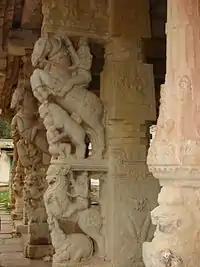Yali (mythology)
Yali (IAST: Yāḻi) is a mythical creature seen in many South Indian temples, often sculpted onto the pillars. It may be portrayed as part lion, part elephant and part horse, and in similar shapes. Also, it has been sometimes described as a leogryph (part lion and part griffin),[1] with some bird-like features.



Descriptions of and references to yalis are very old, but they became prominent in south Indian sculpture in the 16th century. Yalis were believed to be more powerful than the lion, the tiger or the elephant.
Iconography and image
In its iconography and image the yali has a catlike graceful body, but the head of a lion with tusks of an elephant (gaja) and tail of a serpent. Sometimes they have been shown standing on the back of a makara, another mythical creature and considered to be the Vahan of Budha (Mercury). Some images look like three-dimensional representation of yalis. Images or icons have been found on the entrance walls of the temples, and the graceful mythical lion is believed to protect and guard the temples and ways leading to the temple. They usually have the stylized body of a lion and the head of some other beast, most often an elephant (gaja-vyala).[2] Other common examples are: the lion-headed (simha-vyala), horse- (ashva-vyala), human- (nir-vyala) and the dog-headed (shvana-vyala) ones.[3]
Gallery
 Yali in pillars of Puthu Mandapam, Madurai, Tamil Nadu State, India
Yali in pillars of Puthu Mandapam, Madurai, Tamil Nadu State, India Yali in Thiruvannamalai Annamalaiyar Temple, Tiruvannamalai, Tamil Nadu State, India
Yali in Thiruvannamalai Annamalaiyar Temple, Tiruvannamalai, Tamil Nadu State, India Yali pillars at Vittala temple at Hampi, Karnataka state, India
Yali pillars at Vittala temple at Hampi, Karnataka state, India Yali pillars at Ananthasayana temple, Ananthasayanagudi, Karnataka state, India
Yali pillars at Ananthasayana temple, Ananthasayanagudi, Karnataka state, India_(37259217170).jpg.webp) Carved pillar in the 16th century Thousand Pillar Hall, Meenakshi Temple, Madurai
Carved pillar in the 16th century Thousand Pillar Hall, Meenakshi Temple, Madurai Yali pillars at Krishna temple at Hampi, Karnataka state, India
Yali pillars at Krishna temple at Hampi, Karnataka state, India Yali pillars at Bhoganandishvara temple in Chikkaballapur district, Karnataka state, India
Yali pillars at Bhoganandishvara temple in Chikkaballapur district, Karnataka state, India Yali pillars at the Ranganatha temple in Chikkaballapur district, Karnataka state, India
Yali pillars at the Ranganatha temple in Chikkaballapur district, Karnataka state, India Pillars with Yali and Kudure Gombe ("horse doll") at Ranganatha temple, Rangasthala, Chikkaballapur district, Karnataka state, India
Pillars with Yali and Kudure Gombe ("horse doll") at Ranganatha temple, Rangasthala, Chikkaballapur district, Karnataka state, India Yali and rider, Mukteshvara Temple, Bhubaneshwar, Odisha state, India
Yali and rider, Mukteshvara Temple, Bhubaneshwar, Odisha state, India.jpg.webp) Yali and rider, Mukteshvara Temple, Bhubaneshwar, Odisha state, India
Yali and rider, Mukteshvara Temple, Bhubaneshwar, Odisha state, India Image of Yali at Orchha fort, Madhya Pradesh, India
Image of Yali at Orchha fort, Madhya Pradesh, India
See also
- List of mythical creatures
- Prathyangira
- Sharabha or 'Sarabeswara'
- Gajasimha
References
- Dictionary of Hindu Lore and Legend (ISBN 0-500-51088-1) by Anna Dallapiccola
- "Carved wood bracket – description". British Museum. Retrieved 13 December 2011.
- "Sculptural fusion". The Hindu. Chennai, India. 21 January 2007.
- Khandro - Yali & Mukha
External links
| Wikimedia Commons has media related to Yali (Hindu mythology). |
